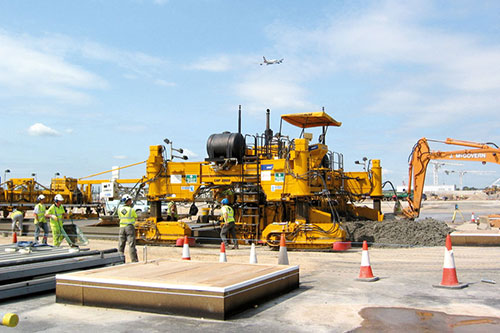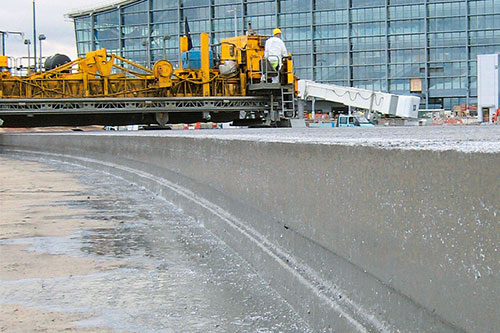GOMACO World Index --- GOMACO World 38.1 - July 2010
Paving Concrete Pavements at Heathrow's T5
by Richard Moore, Technical Associate Director, TPS
A GOMACO four-track GHP-2800 slipforms concrete on the new Terminal 5 (T5) at London Heathrow Airport.
Article and photos reprinted with permission from Concrete Technology Today magazine.
The design and construction of the aircraft pavements for the new Terminal 5 (T5) at London Heathrow Airport presented a number of significant challenges. These challenges were overcome by an integrated project team consisting of BAA (client), TPS (design consultant, part of the Carillion Group) and AMEC Civil Engineering (constructor). The integrated team worked closely in co-located offices from the very early inception of the project in 1997 until the opening day in March 2008.
The London Clay subgrade on the T5 development resulted in an equilibrium CBR of two percent across the majority of the site. The strength was far lower than the naturally occurring gravel subgrades on the existing Heathrow airfield. The low subgrade strength coupled with the extremely high aircraft traffic loads, over 50 percent of the movements being long haul aircraft, resulted in a significant pavement depth being required.
An integrated design and cost model was developed to obtain the best value pavement solution. The costs were built up using real time cost information provided by the two principal contractors and the pavement team; a long-term framework agreement between BAA and AMEC. The design and cost model allowed a large number of options to be quickly and easily evaluated including rigid pavements, flexible pavements and ground improvement options. It was found that a rigid pavement, Pavement Quality Concrete (PQC) on a cement bound base, would provide the best value solution.
Initial design calculations indicated that the PQC depth would be approximately 800 millimeters (31.5 in), well beyond the slipform paving technology at that time. The challenge was to reduce the PQC depth to below 600 millimeters (23.6 in), which is the depth at which the slab could safely be slipformed in a single layer.
The design and cost model highlighted that increasing the strength of the PQC would result in significant reductions in the pavement depth. An increase in the flexural strength of one N/mm2 from six N/mm2 ("F6" - the standard Pavement Team mix at that time) to seven N/mm2 ("F7") would result in an average reduction of 80 millimeters (3.1 in). Applying this reduction to the one million square meters of T5 aircraft pavements would result in substantial cost, program and environmental benefits. Reducing the pavement depth also resulted in less London Clay fill material having to be transported from the main site.
To achieve F7 grade concrete, the design and construction teams commenced mix development in 1999. A large number of laboratory and full-scale production trials were carried out and the concrete was used in a number of airfield projects at Heathrow, Gatwick and Stansted prior to the start onsite at T5. The increased strength was obtained by reducing the water/cement ratio, resulting in a very dry concrete mix. All members of the supply chain were involved from an early stage to ensure that a workable high strength mix could be achieved.
The production and project trials indicated that to achieve success the concrete batching and paving processes would have to be managed as one complete system. A dedicated PQC batching plant and tight control of raw materials, such as aggregate moisture content, aggregate grading, cement and PFA chemical properties, were also key to obtaining a high strength, high quality PQC.
The T5 F7 concrete had a total cementitious content of 380 kilograms per cubic meter (1096 lb/yd3) with 30 percent PFA and contained limestone aggregate. The reduced slab thickness resulting from the use of F7 concrete and the utilization of recycled concrete in the cement bound base and pavement working platform eliminated 27,000 truck movements. Cement production CO2 emissions were reduced by over 60,000 tons as a result of the reduced slab depth and the use of cement replacement.
The new generation of larger aircraft, such as the Airbus A380 and stretched versions of existing aircrafts, result in significantly higher edge stresses on transverse and longitudinal joints. A number of longitudinal joint failures on the existing Heathrow airfield during the design phase of T5 highlighted the importance of achieving good load transfer between adjacent concrete bays. The T5 team developed a new longitudinal joint detail, known as a "tapered key," to increase load transfer and reduce edge stresses. The tapered key joint included a foam top section to eliminate the risk of compression failures, such as those witnessed on the existing Heathrow pavements.
The tapered key joint was easier to construct than the more traditional sinusoidal or dowelled joints and is performing well in operation. BAA has since adopted the new detail on all their new longitudinal joints constructed at Heathrow.
BAA invested in a state-of-the-art slipforming paving machine (a GOMACO four-track GHP-2800) to construct the aircraft pavements. Early construction planning indicated that the phased handover of the airfield and the large number of substructures, service pits and manholes would result in a high proportion of hand-laid concrete. To improve the construction efficiency and the PQC quality, it was essential that the proportion of machine-laid concrete be increased.
The construction team was involved with the design from an early stage. It was important that both the construction planners and the paving team could influence the development of the design. Service pits and manholes were located within the concrete bay pattern to avoid clashes with the paving machine. A new method of slipform paving over the top of pit and manhole covers was also developed. The integrated design and construction team approach resulted in a 30 percent increase in the area of machine-laid concrete.
To minimize the volume of PQC required, the pavement was designed for the specific traffic forecast in each area. For example, the areas adjacent to the terminal buildings were designed for aircraft tugs only and detailed forecasts were used to design each taxiway and groups of aircraft stands. In later phases of the project, the slipform paving machine was adapted to lay variable thickness PQC on the aircraft stands. This allowed the trafficked sections of the stands, such as the centerlines, to be locally deepened and the pavement depth to be reduced elsewhere on the stand. This innovation reduced the PQC volume by 1400 cubic meters (1831 yd3).
A number of other BAA aircraft pavement innovations were developed on T5, including the introduction of unsealed transverse and longitudinal joints and the use of friction testing technology, as opposed to the traditional sand patch test to measure surface texture.
An integrated team approach to the design and construction of the T5 aircraft pavements resulted in significant cost, program, quality and environmental benefits. Early construction team involvement allowed high strength concrete to be developed and the pavement design to be tailored so as to optimize the efficiency of the construction and improve the quality of the finished product.

Concrete Technology Today magazine is published by Trade Link Media Pte Ltd in Singapore. This article originally appeared in their Vol. 3, 2009, edition.
Richard Moore is a Technical Associate Director with TPS's Aviation Engineering team. He worked on Heathrow Terminal 5 and played a leading role in developing high strength (F7) pavement quality concrete and innovative design and construction methodologies. He was also responsible for the runway, taxiway and apron pavement design for Stansted G2 and is currently Design Team Leader for the new Bugesera International Airport in Rwanda. He is the TPS' focal point for developments in pavement design, a subject on which he has written papers and presented to a number of international conferences.
Subscribe to Receive GOMACO World Magazine

